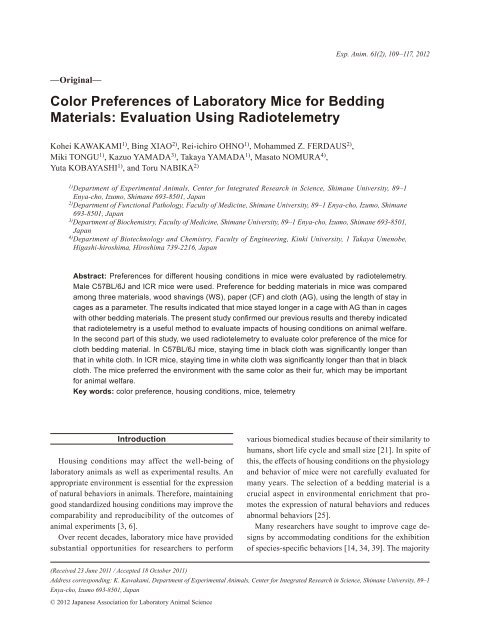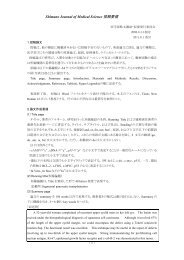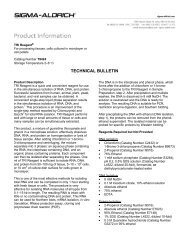Color Preferences of Laboratory Mice for Bedding Materials ...
Color Preferences of Laboratory Mice for Bedding Materials ...
Color Preferences of Laboratory Mice for Bedding Materials ...
You also want an ePaper? Increase the reach of your titles
YUMPU automatically turns print PDFs into web optimized ePapers that Google loves.
Exp. Anim. 61(2), 109–117, 2012—Original—<strong>Color</strong> <strong>Preferences</strong> <strong>of</strong> <strong>Laboratory</strong> <strong>Mice</strong> <strong>for</strong> <strong>Bedding</strong><strong>Materials</strong>: Evaluation Using RadiotelemetryKohei Kawakami 1) , Bing Xiao 2) , Rei-ichiro Ohno 1) , Mohammed Z. Ferdaus 2) ,Miki Tongu 1) , Kazuo Yamada 3) , Takaya Yamada 1) , Masato Nomura 4) ,Yuta Kobayashi 1) , and Toru Nabika 2)1) Department <strong>of</strong> Experimental Animals, Center <strong>for</strong> Integrated Research in Science, Shimane University, 89–1Enya-cho, Izumo, Shimane 693-8501, Japan2) Department <strong>of</strong> Functional Pathology, Faculty <strong>of</strong> Medicine, Shimane University, 89–1 Enya-cho, Izumo, Shimane693-8501, Japan3) Department <strong>of</strong> Biochemistry, Faculty <strong>of</strong> Medicine, Shimane University, 89–1 Enya-cho, Izumo, Shimane 693-8501,Japan4) Department <strong>of</strong> Biotechnology and Chemistry, Faculty <strong>of</strong> Engineering, Kinki University, 1 Takaya Umenobe,Higashi-hiroshima, Hiroshima 739-2216, JapanAbstract: <strong>Preferences</strong> <strong>for</strong> different housing conditions in mice were evaluated by radiotelemetry.Male C57BL/6J and ICR mice were used. Preference <strong>for</strong> bedding materials in mice was comparedamong three materials, wood shavings (WS), paper (CF) and cloth (AG), using the length <strong>of</strong> stay incages as a parameter. The results indicated that mice stayed longer in a cage with AG than in cageswith other bedding materials. The present study confirmed our previous results and thereby indicatedthat radiotelemetry is a useful method to evaluate impacts <strong>of</strong> housing conditions on animal welfare.In the second part <strong>of</strong> this study, we used radiotelemetry to evaluate color preference <strong>of</strong> the mice <strong>for</strong>cloth bedding material. In C57BL/6J mice, staying time in black cloth was significantly longer thanthat in white cloth. In ICR mice, staying time in white cloth was significantly longer than that in blackcloth. The mice preferred the environment with the same color as their fur, which may be important<strong>for</strong> animal welfare.Key words: color preference, housing conditions, mice, telemetryIntroductionHousing conditions may affect the well-being <strong>of</strong>laboratory animals as well as experimental results. Anappropriate environment is essential <strong>for</strong> the expression<strong>of</strong> natural behaviors in animals. There<strong>for</strong>e, maintaininggood standardized housing conditions may improve thecomparability and reproducibility <strong>of</strong> the outcomes <strong>of</strong>animal experiments [3, 6].Over recent decades, laboratory mice have providedsubstantial opportunities <strong>for</strong> researchers to per<strong>for</strong>mvarious biomedical studies because <strong>of</strong> their similarity tohumans, short life cycle and small size [21]. In spite <strong>of</strong>this, the effects <strong>of</strong> housing conditions on the physiologyand behavior <strong>of</strong> mice were not carefully evaluated <strong>for</strong>many years. The selection <strong>of</strong> a bedding material is acrucial aspect in environmental enrichment that promotesthe expression <strong>of</strong> natural behaviors and reducesabnormal behaviors [25].Many researchers have sought to improve cage designsby accommodating conditions <strong>for</strong> the exhibition<strong>of</strong> species-specific behaviors [14, 34, 39]. The majority(Received 23 June 2011 / Accepted 18 October 2011)Address corresponding: K. Kawakami, Department <strong>of</strong> Experimental Animals, Center <strong>for</strong> Integrated Research in Science, Shimane University, 89–1Enya-cho, Izumo 693-8501, Japan© 2012 Japanese Association <strong>for</strong> <strong>Laboratory</strong> Animal Science
COLOR PREFERENCES OF MICE FOR BEDDING MATERIALS 111Fig. 1. The preference test system with mice. (A) Types <strong>of</strong> cage floor covering. From left to right: wood shavings(WS, Clean-chip TM ), paper (CF, Care-feeaz TM ), cloth (AG, Agrebe TM ). (B) Types <strong>of</strong> cage floorcovering. From left to right: black cloth (Agrebe TM ), white cloth (Agrebe TM ). (C) Two-direction device:two identical test cages connected to a central cage. (D) Three-direction device: three identical testcages connected to a central cage.half was <strong>for</strong> data acquisition. Staying time and activitywere recorded every 10 min. Preference <strong>for</strong> the beddingmaterials was assessed by calculating staying time percage, and resting time was defined as a period with noactivity.Experimental procedureExperiment 1: Experiments were designed to comparetwo bedding materials in C57BL/6J mice. As shown inFig. 1C, the preference tests consisted <strong>of</strong> three groupcomparisons: WS and CF, CF and AG, and AG and WS.The time course <strong>of</strong> experiments is shown in Fig. 2. <strong>Mice</strong>were randomly allocated to three groups as shown in thefigure to avoid bias due to the experimental order. Experimentswere started using mice at the age <strong>of</strong> 8 weeks.Experiment 2: Experiments were carried out to comparethe three bedding materials in C57BL/6J mice (Fig.1D); preference tests consisted <strong>of</strong> one group comparison:WS, CF, and AG. Experiments were started using miceat the age <strong>of</strong> 8 weeks.Experiment 3: Using the apparatus shown in Fig. 1C,experiments were carried out to compare the two colorsFig. 2. Experimental design <strong>for</strong> experiment 1.(black cloth and white cloth) in terms <strong>of</strong> the preferences<strong>of</strong> C57BL/6J and ICR mice (Fig. 1B). Experiments werestarted using mice at the age <strong>of</strong> 8 weeks.Statistical analysisData are expressed as means ± SEM. Differences weretested with analysis <strong>of</strong> variance (ANOVA) and theScheffe post hoc test. Analyses were per<strong>for</strong>med usingStatView (SAS Institute Inc., Cary, NC, USA). A P
112K. KAWAKAMI, ET AL.Fig. 3. Comparison <strong>of</strong> the period <strong>of</strong> stay <strong>of</strong> mice in each combination <strong>of</strong> bedding materialsunder light and dark phases using a two-direction device. Data represent means ± SEM(n=12). **: P
COLOR PREFERENCES OF MICE FOR BEDDING MATERIALS 113Fig. 5. Comparison <strong>of</strong> locomotor activity <strong>of</strong> mice in each combination <strong>of</strong> bedding materialsunder light and dark phases using a two-direction device. Data represent means ± SEM(n=12). **: P
114K. KAWAKAMI, ET AL.Fig. 6. Comparison <strong>of</strong> behavior <strong>of</strong> mice in three floor combinations<strong>of</strong> bedding materials using a three-direction device.(A) Staying time, (B) resting time, and (C) activity. Datarepresent means ± SEM (n=12). * and **: P
COLOR PREFERENCES OF MICE FOR BEDDING MATERIALS 115ing and hiding within the cloth bedding material. Bytheir periods <strong>of</strong> stay among the three cages containingWS, CF, and AG, a difference in kinds <strong>of</strong> behavior <strong>of</strong>the mice between the light and dark periods was suggested(Fig. 6A and 6C). In both experiment 1 and experiment2, mice were found to strongly prefer the clothbedding material compared with the other materials. Asimilar result was obtained in our other study in whichboth male and female ICR mice had a strong preference<strong>for</strong> the cloth bedding materials compared with the othermaterials [33]. This suggests that the flexibility, hygroscopicity,and heat-retaining properties <strong>of</strong> cloth are com<strong>for</strong>table<strong>for</strong> mice [23]. However, compared with woodshavings or paper, observation <strong>of</strong> an animal in the clothbedding material cannot be carried out easily [22].In experiment 3, we used C57BL/6J and ICR mice.C57BL/6J mice are an inbred strain; they are commonlyused <strong>for</strong> embryo transfer and intergenic recombination,so we also utilized this strain here; although ICRmice are from a closed colony, we used them here <strong>for</strong>the fundamental study <strong>of</strong> the bedding materials <strong>of</strong> mice[22, 24, 32]. <strong>Laboratory</strong> mice showed clear and consistentindividual preferences <strong>for</strong> cloth bedding materialsimilar in color (black and white) to the fur <strong>of</strong> strains <strong>of</strong>both C57BL/6J and ICR mice. However, this does notexplain why mice preferred places with a similar colorto their fur; it could have been motivated by fear via aconditioned place preference mechanism. Among mammals,trichromatic vision has only been observed inprimates. This is because they have three types <strong>of</strong> conephotoreceptor, each <strong>of</strong> which is maximally sensitive toshort (S), middle (M), or long (L) wavelengths <strong>of</strong> light[31]. Most mammals, including mice, are dichromats,possessing only S and M cone pigments, and there<strong>for</strong>ethe brains <strong>of</strong> mice did not need to evolve to make thesediscriminations [20, 37]. Relatively little is known aboutcolor vision in mice. In a recent investigation on colorpreferences, Sherwin et al. [35] reported that CBA micepreferred a white cage the most and a red cage the least.The preference <strong>for</strong> white contradicts results by Martinezet al. [27] and Arnedo et al. [2], who reported that, be<strong>for</strong>econditioned place preference tests, mice preferred blackover white places. Their visual apparatus is basicallysimilar to that <strong>of</strong> humans [10, 29], and the retinal ganglioncells have spectral sensitivity in the range <strong>of</strong>360–640 nm [18]. Cone photoreceptor cells <strong>of</strong> highervertebrates act under daylight conditions, and their characteristiccolor sensitivities are attributed to the visualpigments having unique absorption spectra [30]. Someresearchers have suggested that mice have the capacity<strong>for</strong> color vision [17], but others have made inconclusivestatements such as “whether mice have color vision isan open question” [1]. However, to ensure good welfare,we must understand the requirements <strong>of</strong> the animals, <strong>for</strong>which bedding material similar in color to their fur ispreferable.Measuring the strength <strong>of</strong> preference by examiningthe strength <strong>of</strong> motivation <strong>for</strong> a certain option makespreference tests even more valuable [36, 38]. Behavioralobservations in the home cage can be used to studysuch factors as differences in the behavioral repertoireafter changing the living conditions <strong>of</strong> the animals.Animal well-being is, in general, related to a broad behavioralrepertoire, meaning that assessment <strong>of</strong> an animal’swell-being requires a thorough knowledge <strong>of</strong> theanimal’s species-specific behavior and biology.In conclusion, the present study indicated that radiotelemetryis a useful approach <strong>for</strong> evaluation <strong>of</strong> environmentalpreferences in laboratory mice. The preferencetest <strong>for</strong> the colors (black and white) <strong>of</strong> cloth beddingmaterials showed that the C57BL/6J mice preferred stayingin black cloth and that the ICR mice preferred stayingin white cloth, namely, in materials with protectivecoloring. Protective coloring <strong>of</strong> cloth bedding materialsmay present several advantages in terms <strong>of</strong> animal welfare.Further studies are needed to examine the relationshipbetween protective coloring and the color <strong>of</strong> fur ininbred strains <strong>of</strong> mice.References1. Applebury, M.L., Antoch, M.P., Baxter, L.C., Chun, L.L.Y.,Falk, J.D., Farhangfar, F., Kage, L., Krzystolik, M.G., Lyass,L.A., and Robbins, J.T. 2000. The murine cone photoreceptor:a single cone type expresses both S and M opsins withretinal spatial patterning. Neuron 27: 513–523. [Medline][CrossRef]2. Arnedo, M.T., Salvador, A., Martinez-Sanchis, S., and Gonzalez-Bono,E. 2000. Rewarding properties <strong>of</strong> testosterone inintact male mice: a pilot study. Pharmacol. Biochem. Behav.65: 327–332. [Medline] [CrossRef]3. Baumans, V. 2004. Methods <strong>for</strong> evaluation <strong>of</strong> laboratory animalwell-being. ATLA 32: 161–162.4. Baumans, V. 1997. Environmental enrichment: practical applications.pp. 187–191. In: Animal Alternatives, Welfareand Ethics (van Zutphen L.F.M. and Balls M. eds.), Elsevierscience B.V., Amsterdam.5. Baumans, V., Stafleu, F.R., and Bouw, J. 1987. Testing housingsystems <strong>for</strong> mice: the value <strong>of</strong> a preference test. Z. Ver-
116K. KAWAKAMI, ET AL.suchstierkd. 29: 9–14. [Medline]6. Beynen, A.C. 1991. The basis <strong>for</strong> standardization <strong>of</strong> animalexperimentation. Scand. J. Lab. Anim. Sci. 18: 95–99.7. Blom, H.J.M., Van Tintelen, G., Baumans, V., and Van DenBroek, J. 1995. Development and application <strong>of</strong> a preferencetest system to evaluate housing conditions <strong>for</strong> laboratoryrats. Appl. Anim. Behav. Sci. 43: 279–290. [CrossRef]8. Blom, H.J.M., Van Tintelen, G., Van Vorstenbosch,C.J.A.H.V., Baumans, V., and Beynen, A.C. 1996. <strong>Preferences</strong><strong>of</strong> mice and rats <strong>for</strong> types <strong>of</strong> bedding material. Lab.Anim. 30: 234–244. [Medline] [CrossRef]9. Blom, H.J.M., Van Vorstenbosch, C.J.A.H.V., Baumans,V., Hoogervorst, M.J.C., Beynen, A.C., and Van Zutphen,L.F.M. 1992. Description and validation <strong>of</strong> a preference testsystem to evaluate housing conditions <strong>for</strong> laboratory mice.Appl. Anim. Behav. Sci. 35: 67–82. [CrossRef]10. Calderone, J.B. and Jacobs, G.H. 1995. Regional variationsin the relative sensitivity to UV light in the mouse retina. Vis.Neurosci. 12: 463–468. [Medline] [CrossRef]11. Chamove, A.S. 1989. Cage design reduces emotionality inmice. Lab. Anim. 23: 215–219. [Medline] [CrossRef]12. Clement, J.G., Mills, P., and Brockway, B. 1989. Use <strong>of</strong> telemetryto record body temperature and activity in mice. J.Pharmacol. Methods 21: 129–140. [Medline] [CrossRef]13. Dawkins, M.S. 1990. From an animal’s point <strong>of</strong> view: motivation,fitness, and animal welfare. Behav. Brain Sci. 13:1–9. [CrossRef]14. Dean, S.W. 1999. Environmental enrichment <strong>of</strong> laboratoryanimals used in regulatory toxicology studies. Lab. Anim.33: 309–327. [Medline] [CrossRef]15. Einstein, R., Billing, R.L., Singh, A., and Chin, I. 2004.Implanted telemetry transmitters alter the noradrenergic responsein vas deferens from mice. ATLA 32: 171–176.16. Eisen, E.J. 1966. Comparison <strong>of</strong> two cage rearing regimes onreproductive per<strong>for</strong>mance and body weight <strong>of</strong> the laboratorymouse. Lab. Anim. Care 16: 447–453. [Medline]17. Ekesten, B. and Gouras, P. 2001. Identifying UV-cone responsesin the murine superior colliculus. Vision Res. 41:2819–2825. [Medline] [CrossRef]18. Ekesten, B., Gouras, P., and Yamamoto, S. 2000. Cone inputsto murine retinal cell. Vision Res. 40: 2573–2577. [Medline][CrossRef]19. Ishii, K., Kuwahara, M., Tsubone, H., and Sugano, S. 1996.The telemetric monitoring <strong>of</strong> heart rate, locomotive activity,and body temperature in mice and voles (Microtus arvalis)during ambient temperature changes. Lab. Anim. 30: 7–12.[Medline] [CrossRef]20. Jacobs, G.H., Williams, G.A., Cahill, H., and Nathans, J.2007. Emergence <strong>of</strong> novel color vision in mice engineeredto express a human cone photopigment. Science 315: 1723–1725. [Medline] [CrossRef]21. Jensen, P. and Toates, F.M. 1993. Who needs “behaviouralneeds”? Motivational aspects <strong>of</strong> the needs <strong>of</strong> animals. Appl.Anim. Behav. Sci. 37: 161–181. [CrossRef]22. Kawakami, K., Komura, K., Nishimura, T., Ichino, M., Ago,A., Takasue, K., Nabika, T., and Harada, T. 2005. Evaluation<strong>of</strong> a new bedding material (Agrebe TM ) <strong>for</strong> mice. Kyusyu J.Exp. Anim. 21: 13–19.23. Kawakami, K., Shimosaki, S., Nishimura, T., Takesue, K.,Nomura, M., Kobayashi, Y., and Nabika, T. 2007. Effects <strong>of</strong>dwelling conditions on cardiovascular parameters in spontaneouslyhypertensive rats. Clin. Exp. Pharmacol. Physiol.34: S45–S46. [CrossRef]24. Kawakami, K., Shimosaki, S., Tongu, M., Kobayashi, Y.,Nabika, T., Nomura, M., and Yamada, T. 2007. Evaluation <strong>of</strong>bedding and nesting materials <strong>for</strong> laboratory mice by preferencetests. Exp. Anim. 56: 363–368. [Medline] [CrossRef]25. Kawakami, K., Takeuchi, T., Ago, A., and Gonda, T. 2002.Influence <strong>of</strong> environmental factors on the development<strong>of</strong> stroke in stroke-prone spontaneously hypertensive rats(SHRSP): effects <strong>of</strong> residential condition and populationdensity. Shimane J. Med. Sci. 20: 13–18.26. Krohn, T.C., Hansen, A.K., and Dragsted, N. 2003. Telemetryas a method <strong>for</strong> measuring the impact <strong>of</strong> housing conditionson rats’ welfare. Anim. Welf. 12: 53–62.27. Martínez, M., Guillensalazar, F., Salvador, A., and Simom,V.M. 1995. Successful intermale aggression and conditionedplace preference in mice. Physiol. Behav. 58: 323–328.[Medline] [CrossRef]28. Mench, J.A. 1994. Environmental enrichment and exploration.Lab Anim. (NY) 23: 38–41.29. Neitz, M. and Neitz, J. 2001. The uncommon retina <strong>of</strong> thecommon house mouse. Trends Neurosci. 24: 248–250.[Medline] [CrossRef]30. Okano, T., Kojima, D., Fukada, Y., Shichida, Y., and Yoshizawa,T. 1992. Primary structures <strong>of</strong> chicken cone visualpigments: vertebrate rhodopsins have evolved out <strong>of</strong> cone visualpigments. Proc. Natl. Acad. Sci. U.S.A. 89: 5932–5936.[Medline] [CrossRef]31. Onishi, A., Koike, S., Ida, M., Imai, H., Shichida, Y., Takenaga,O., Hanazawa, A., Konatsu, H., Mikami, A., Goto,S., Suryobroto, B., Kitahara, K., and Yamamori, T. 1999.Dichromatism in macaque monkeys. Nature 402: 139–140.[Medline]32. Sakamoto, J., Kawakami, K., Ohno, R., Tongu, M., Komura,K., Ozaki, K., Maruo, N., and Yamada, T. 2010. The durabilityand the preference <strong>of</strong> cloth bedding materials, differentin the yarn strength and the weave, against mice gnawing.Kyusyu J. Exp. Anim. 26: 41–47.33. Sakamoto, J., Kawakami, K., Ozaki, K., Maruo, N., Tongu,M., and Yamada, T. 2009. <strong>Preferences</strong> <strong>of</strong> laboratory mice <strong>for</strong>bedding materials. Kyusyu J. Exp. Anim. 25: 119.34. Sherwin, C.M. 2002. Com<strong>for</strong>table quarters <strong>for</strong> mice in researchinstitutes. pp. 6–17. In: Com<strong>for</strong>table Quarters <strong>for</strong> Animals(Reinhardt, V. and Reinhardt, K. eds.), Animal WelfareInstitute, Washington, D.C.35. Sherwin, C.M. and Glen, E.F. 2003. Cage colour preferencesand effects <strong>of</strong> home cage colour on anxiety in laboratorymice. Anim. Behav. 66: 1085–1092. [CrossRef]36. Sherwin, C.M. and Nicol, C.J. 1997. Behavioural demandfunctions <strong>of</strong> caged laboratory mice <strong>for</strong> additional space.Anim. Behav. 53: 67–74. [CrossRef]37. Szél, A., Csorba, G., Catte, A.R., Szel, G., Rohlich, P., andVan Veen, T. 1994. Different patterns <strong>of</strong> retinal cone topographyin two genera <strong>of</strong> rodents. Cell Tissue Res. 276: 143–150.[Medline] [CrossRef]
COLOR PREFERENCES OF MICE FOR BEDDING MATERIALS 11738. Van de Weerd, H.A., Van Loo, P.L.P., Van Zutphen, L.F.M.,Koolhaas, J.M., and Baumans, V. 1997. <strong>Preferences</strong> <strong>for</strong> nestingmaterial as environmental enrichment <strong>for</strong> laboratorymice. Lab. Anim. 31: 133–143. [Medline] [CrossRef]39. Van Loo, P.L.P., Kruitwagen, C.L.J.J., Koolhaas, J.M., Vande Weerd, H.A., Van Zutphen, L.F.M., and Baumans, V.2002. Influence <strong>of</strong> cage enrichment on aggressive behaviourand physiological parameters in male mice. Appl. Anim. Behav.Sci. 76: 65–81. [CrossRef]40. Weinert, D. and Waterhouse, J. 1998. Diurnally changing effects<strong>of</strong> locomotor activity on body temperature in laboratorymice. Physiol. Behav. 63: 837–843. [Medline] [CrossRef]41. Weiss, J., Ernst, A., and Schick, K.L. 1982. The laboratoryrat: preference <strong>for</strong> size and shape <strong>of</strong> living cage. Z. Versuchstierkd.24: 193–201. [Medline]42. Wiepkema, P.R. and Koolhaas, J.M. 1993. Stress and animalwelfare. Anim. Welf. 2: 195–218.43. Wu, M.W., Li, X.M., Xian, L.J., and Levi, F. 2004. Effects<strong>of</strong> meal timing on tumor progression in mice. Life Sci. 75:1181–1193. [Medline] [CrossRef]




![éèå§äº¢é²çã«å¯¾ããIVR[ PDF: 2.3MB] - å³¶æ ¹å¤§å¦å»å¦é¨](https://img.yumpu.com/47211535/1/190x143/eeaaecaa-3-4-aaivr-pdf-23mb-aae-aa-aa-e.jpg?quality=85)



